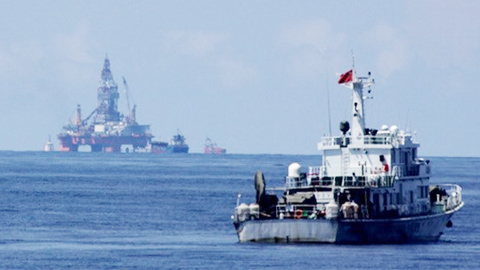|
China’s tripod art of war
Two months before the Permanent
Court of Arbitration (PCA) made its statement on the case between the
Philippines and China, China launched a global media campaign.

The illegal deployment of HD-981 oil rig deep in the exclusive
economic zone (EEZ) and continental shelf of Vietnam in 2014 is a
"daring test" of China in the face of response of related countries
as well as international public opinion.
As China announced the unjustified nine-dotted line in
the East Sea (internationally known as the South China Sea) in 2009, China
has been under pressure from public opinion throughout the world. It, thus,
launched the so-called tripod art of war on the fronts of information.
This strategy is close collaboration between the psychological, legal and media fronts. Simply, this is a strategy to create beneficial information for China, at a similar frequency to unfavorable information to China. The core of the information is the ability to impose national rules on the "disputed territory" and interpretation of international law "Chinese-style" to legalize all field of actions of China on the legal front. The next is a series of diplomatic - economic - military measures with other countries. China will pour huge investment capital in return for the support of other countries to its East Sea issue. And finally, on the media front, China will take full advantage of its national media to disseminate information that is beneficial to China to the outside world at the highest frequency. The tripod art of war was used by China in many important international issues and has been strongly deployed to support China’s East Sea dispute since 2009. The launch of the "U-shaped line" in 2009, a ban on annual fishing in the East Sea since 2010, the establishment of the illegal "Sansha city" in 2012, and unilateral military exercises in the East Sea were the first moves on the legal front. The illegal deployment of HD-981 oil rig deep in the exclusive economic zone (EEZ) and continental shelf of Vietnam in 2014 is a "daring test" of China in the face of response of related countries as well as international public opinion. In this event, China initially utilized its embassies in several countries (Indonesia, USA, Australia, Japan, Thailand ...) to publish publications about the East Sea under Chinese view. This is an important variation of the approach of the Chinese on the media front: using a team of ambassadors to attack in Western and international media. The information front before the storm Two months before the PCA made its statement about the lawsuit against China filled by the Philippines, China launched a media campaign on a global scale. In particular, the Chinese ambassadors in more than 30 countries across five continents published publications on the East Sea on the news agencies of great influence such as Bloomberg (USA), The Time (UK), Straits Times (Singapore), The Star (Malaysia), Jakarta Post (Indonesia) and news agencies in England, Germany, Canada, Australia, USA, South Africa, India, France, Brazil .... The content of more than 30 publications about the East Sea disputes by the Chinese ambassadors focused on the five areas as follows: Firstly, confirming the historical claims of China in the East Sea. Secondly, demonstrating China's compliance with international law through peaceful bilateral delimitation of territory between China and its 12/14 neighbors, while also showing respect for multilateral and international treaties which China signed. More than 2/3 of the publications mentioned Article 298 of the UN Convention on the Law of the Sea (UNCLOS) on the immunity of China. Thirdly, emphasizing that only bilateral negotiations and consultations could resolve the disputes in the East Sea. Fourthly, China unintentionally caused tension in the region (20/33 publications concluded that China was a victim of harassment by other countries). And finally, all the previous bilateral consultations between China and the Philippines were ineffective due to the noncooperation of the Philippines. Therefore, the Philippines was the party that breached agreements and unilaterally filed a lawsuit to the PCA to make the situation even more complicated. These were"Chinese style" interpretations done to jam public opinion and distribute adverse information before the PCA made the ruling. However, it should be noted that even Chinese ambassadors were "very shy" when they presented the two arguments: the first is that China did not intend to build military bases in the East Sea (7/33 publications) and secondly the argument to reject the jurisdiction of the PCA (4/33 publications). Most articles argued that China has immunity under their 2006 statement, and the PCA was only unilateral efforts of the Philippines. They tried to avoid direct reference to the commentary to refute the jurisdiction of the PCA as they found disadvantages on a legal basis. However, China’s information front is not enough to change the perception based on logic and real evidence of international opinion. VNN Luc Minh Tuan CSIS, HCM City University of Social Sciences and Humanities |
Thứ Hai, 17 tháng 10, 2016
Đăng ký:
Đăng Nhận xét (Atom)
Không có nhận xét nào:
Đăng nhận xét